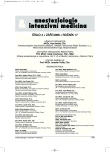Perioperative spinal cord monitoring during spinal surgery
Authors:
I. Čundrle; M. Mokrá 1; Martin Němec 2; J. Bednařík 2; R. Chaloupka 3
Authors‘ workplace:
Klinika anesteziologie, resuscitace a intenzivní medicíny, FN Brno
1; Neurologická klinika FN Brno
2; Ortopedická klinika FN Brno
3
Published in:
Anest. intenziv. Med., 17, 2006, č. 4, s. 187-192
Category:
Anaesthesiology - Original Paper
Overview
Objective:
To compare two methods of perioperative spinal cord monitoring during spinal deformity correction surgery.
Desing:
Observational study.
Setting:
Department of Anaesthesiology and Intensive Care, Department of Orthopaedic Surgery, University Hospital Brno.
Materials and Methods:
Patients admitted to the orthopaedic ICU in 1980–2005 were divided to groups 1–4 of 294, 235, 410 and 116 patients. Patients in groups 1–3 were monitored with the wake-up test in the course of three different anaesthetic techniques. Patients in group 4 were monitored using combined monitoring of somatosensory (SEP) and motor evoked potentials (MEP). We used standard statistical methods with P-value < 0.05 considered significant.
Results:
The wake-up test revealed 3, 3 and 1 cases of paraplegia in groups 1–3 respectively. The paraplegia disappeared after releasing the retraction in all the cases. Three and two cases of clinically relevant paraplegia were diagnosed by SEP and MEP respectively in group 4. None of them lead to a persistent postoperative deficit.
Conclusion:
The authors prefer the methods utilising evoked potentials, because they are a more accurate and continuous indicator of spinal cord ischaemia. The wake up test can be also used.
Keywords:
perioperative spinal cord monitoring – surgical correction of spinal deformity – neurological deficit – wake up test – somatosensory and motor evoked potentials
Labels
Anaesthesiology, Resuscitation and Inten Intensive Care MedicineArticle was published in
Anaesthesiology and Intensive Care Medicine

2006 Issue 4
Most read in this issue
- Difficult Airways – prediction and management
- Death of a novice scuba diver after sudden emergence from a 5-meter depth – case report
- Perioperative spinal cord monitoring during spinal surgery
- New developments in haemodynamic monitoring: Part I
